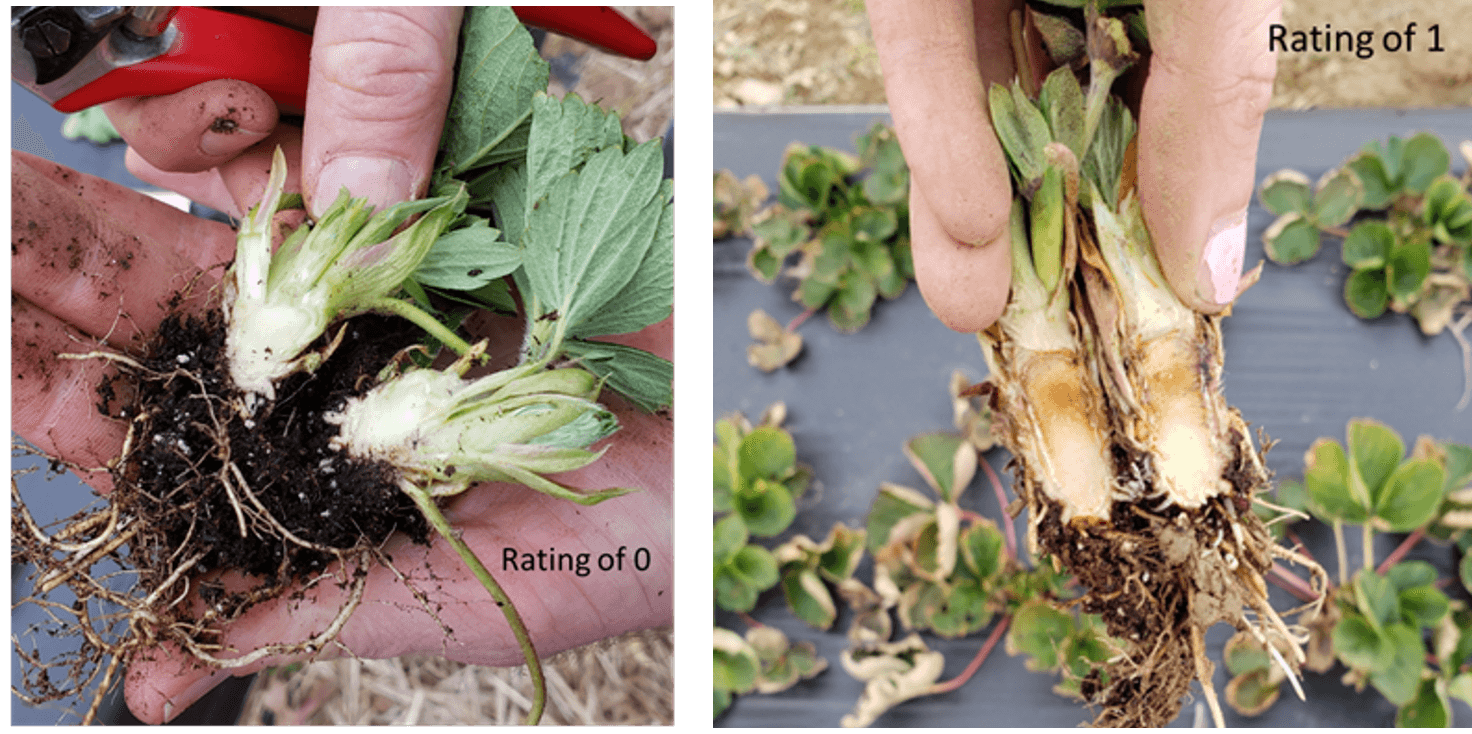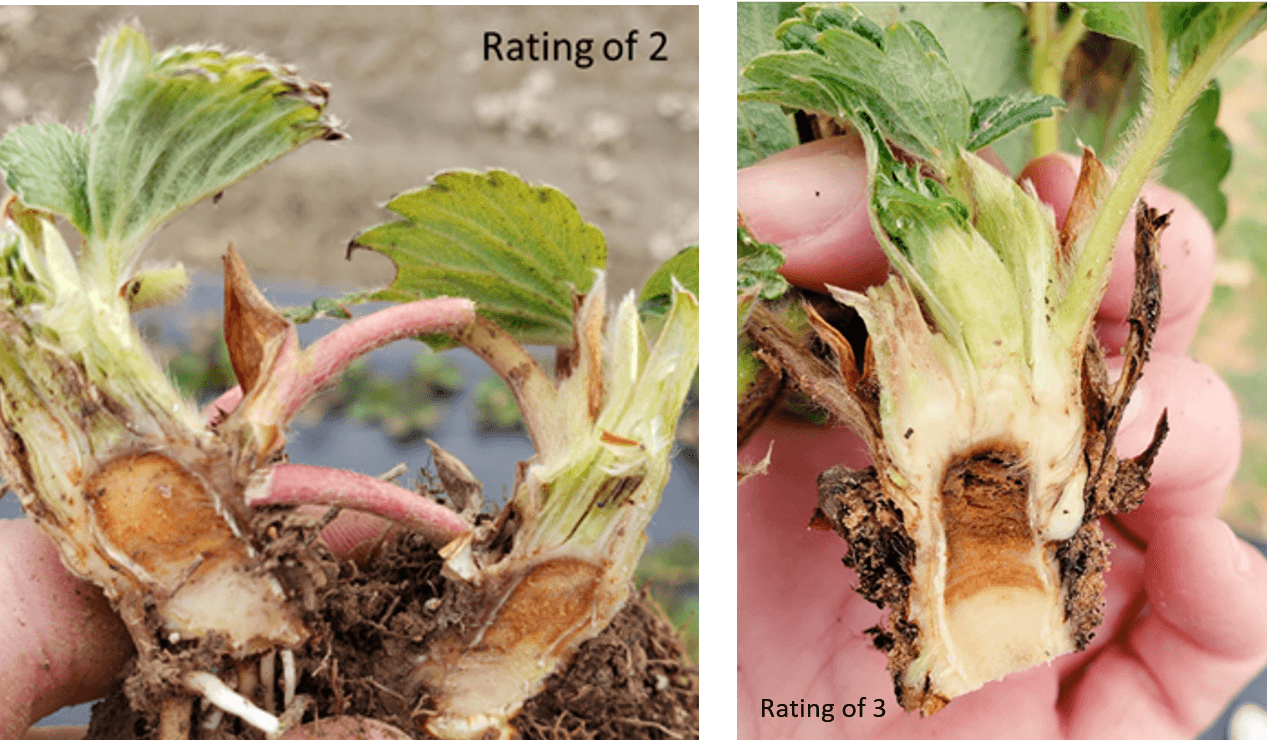
Impact of Fall Cold Injury to Strawberry Crowns on Spring Yield
As we move into the fall, in come the cooler temperatures. Here's what happened after the Veteran's Day freeze last November and how it affected strawberry yields in the spring!

Tweet from the National Weather Service Little Rock last November with a map showing temperature change across the state.
In early November of 2019 a cold front moved across the Southeast on Veterans day, and brought drops in temperature of 40-50°F across the state of Arkansas. Lows temperatures dipped to 13-14 °F statewide on Tuesday November 12th, 2019 and in some cases set new low temperature records for that day. The temperatures remained cool throughout that day and into the next day.
Once properly acclimated to cold temperatures strawberry crowns are cold hardy to around 10°F and leaves are hardy to around 22° F. The process of cold acclimation in plants generally starts as the day length shortens and colder temperatures near freezing occur. These events signal to the plant to start the process of acclimating for cold temperatures and preparing for dormancy. However, the Veterans day freeze was the first time during the fall of 2019 that temperatures dropped below freezing for many places in the state, so recently planted strawberry plants and many other plants had not yet acclimated to cold temperatures.
The early occurrence of the cold weather also meant not all growers had their row covers ready or could only cover parts of their fields. Additionally, initial forecasts of rain occurring around the event meant there was a risk of applying a row cover and having it freeze to the plants which provides no protection and can damage the plants.
Due to these factors we suspected that strawberry crowns had suffered cold injury.
Starting a week after the deep freeze occurred in November 2019 we cut strawberry crowns at five locations in AR to assess if any damage occurred.
Here are the locations where we assessed strawberry crowns for cold injury:
- Fayetteville (13°F on 11/12/19) (Zone 7a)
- Clarksville (16°F on 11/12/19) (Zone 7b)
- Hope (14°F on 11/12/19) (Zone 8a)
- White County (No recorded low at location for 11/12/19) (Zone 7b)
- Kibler, AR (13-14°F on 11/12/19) (Zone 7b) (Variety Trial Location)
Cold injury appears in strawberry crowns as a darkening of the center tissue or pith. Often the cold injury will be more prevalent at the top of the crown and will move downward.
We developed a system to rate the severity of cold injury we observed:
- 0 - No injury, no signs of cold damage
- 1 - Minor injury, light brown discoloration in less than 50% of the crown
- 2- Moderate injury, medium brown discoloration in more than 50% of the crown
- 3- Severe injury, dark brown discoloration in more than 50% of the crown and some necrosis of the tissue
See the images below for examples of the levels of injury.

Left) Strawberry crown showing no signs of cold damage, notice how the entire crown is a clear ivory white color. Fayetteville, AR. (Photos: Amanda McWhirt)

Strawberry crown major pith darkening due to cold damage. The lower cambium and pith is still white which may mean the plant will recover and survive, but will have a significant yield reduction. Hope, AR (Photos: Amanda McWhirt)
Factors That Impact the Occurrence of Cold Damage on Strawberry Crowns
From our evaluations across the state here were some factors that were determined to impact the occurrence of cold injury to strawberry crowns:
- Plants that had row covers did not show signs of cold damage during this event
- Plants that were left uncovered showed varying levels of cold damage, some significant
- The amount and severity of damage varied based on plant vigor, plant size, location
within the field, and variety
- The north side of the rows tended to show more damage than the south sides of the row
- We observed a large amount of variability within fields, likely due to low spots where cold air pooled in the field
- Differences between varieties:
- Rocco, Chandler, and Camarosa showed very low to no cold damage (average rating of ≤ 1)
- Ruby June showed variable levels of cold injury, in some cases severe, likely due in part to plant size, which was small in some locations
- Fronteras and Albion showed severe cold damage when left uncovered (average rating of 2)
- Weak plants with small crown size showed more damage than plants of the same cultivar with larger diameter crowns. This was particularly noticeable on late plantings where plants had small crowns.
Impacts on Crown Development and Yield
Strawberry plants in the fall are building crowns and initiating floral buds in the crown for the next spring. Damage to the crown therefore means a likely reduction in the crown growth, floral bud initiation and ultimately yield.
- The extent to which yield is impacted depends on where in the crown the damage is observed and the severity of damage.
- Typically, if damage occurs it starts at the top of the crown where the crown is more exposed and then moves downward through the pith into deeper parts of the crown. The pith is the middle part of the crown where the plant develops its floral buds and runners.
- Alternatively, damage to the crown can be more severe if the vascular tissue (cambium) (AKA the plumbing for the plant) is damaged. In the pictures of the cold damage ratings the cambium can be seen as the two clear white lines on either side of the crown. If this part of the crown is damaged the effect is more likely to result in severe reductions in yield and even plant death.
Potential for Crown Recovery
In order to determine the potential for strawberry crowns to recover from cold injury that occurs in the fall in March of 2020 we re-cut crowns and examined for symptoms of cold injury at the Kibler location. This location is where we were conducting a variety trial and the site was not able to be covered during the November 2019 freeze. Our results show that some cultivars are more susceptible to cold injury, while others are better able to recover from cold injury. Overall the location had an average cold damage rating of 2.19 across all cultivars after the November freeze.
During assessments made in the spring at the Kibler location it was observed that:
Strawberry crowns with a fall cold injury rating of 0- 2 in general showed recovery in the crown tissues (showed less damage or no damage) upon being examined in the spring.
- Example: Rocco, Camino Real and Sweet Charlie showed recovery of the crown tissue from cold injury in the spring and all had lower ratings of cold damage in the spring compared to their averages in the fall.
Strawberry crowns with a fall cold injury rating of 2-3 generally did not show recovery of the crown tissue from cold damage and often cold damage symptoms were worse in the spring.
- Example: Fronteras and Albion had the highest ratings of cold damage in the fall and still showed major symptoms of cold injury in the spring.
Because we weren’t able to compare our yields to plants with no cold injury we cannot make assumptions about how cold injury impacted yields. However, it is assumed that the damage did negatively impact yields to some degree and Albion and Fronteras were among the lowest yielding cultivars at this site in 2019-2020.
Marketable Strawberry Yields at University of Arkansas Vegetable Research Station, 2019-2020
| Cultivar | Average Marketable Yield (lbs./per plant) | Average Spring Cold Damage Rating |
| Albion | 0.60 | 2.3 (Moderate) |
| Fronteras | 0.85 | 3.0 (Severe) |
| All Other Cultivars | 1.12 | 1.0 (Minor) |
*There were high rates of rain and hail damaged berries in this trial, which resulted in lower marketable yields
From these assessments we recommend growers have row covers on-site and ready early in the fall. Also it is important to be aware of differences in cold damage susceptibility between varieties and locations in the field when making decisions about which plants to cover.
Best wishes for a successful 2021 strawberry season!